Pregnancy and Oral Health
I am pregnant and concerned about my oral health.
Pregnancy is a very special time when you need to take better care of yourself to get your baby’s life off to a good start and to prepare for everything involved in caring for your infant. Your oral health is now more important than ever. If you have enjoyed good dental health in the past you should encounter few problems during pregnancy. If you have dental problems, including untreated disease, you should seek dental advice as soon as possible. Regardless of your oral health, now is a good time to visit your dentist and dental hygienist to make sure that dental problems will not interfere in any way as your pregnancy progresses.

WHAT ORAL HEALTH PROBLEMS MAY OCCUR DURING MY PREGNANCY?
Changes in the gums – pregnancy gingivitis
The most common problem in pregnancy is changes in the gums, as they react more aggressively to any build-up of dental plaque. Most women notice that their gums change from pale pink to deeper red and that they may bleed on gentle brushing. This is often referred to as pregnancy gingivitis. It frequently starts at about eight weeks and peaks in the eighth month and ends shortly after delivery.
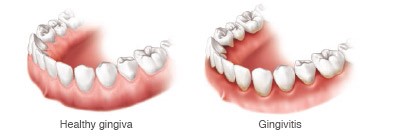
Figure: The left teeth and gums are healthy and normal. The gums on the right are showing signs of gum disease – redness and swelling.
How is it caused?
The changes in your body, such as increased levels of hormones and the way your immune system works, can result in changes in how your gums react to dental plaque. During pregnancy, the gums react to the presence of any dental plaque more aggressively than normal. So even if you had very healthy gums before the pregnancy and kept the same standards of plaque control and oral hygiene, it is possible for gingivitis to develop during pregnancy with only very low levels of dental plaque.
What are the warning signs?
Gums that look red, bleed easily on gentle toothbrushing, or perhaps feel sensitive are the only warning signs. The presence of blood when spitting out or rinsing out toothpaste is another common sign for all types of gum diseases.
Changes in gums – pregnancy granuloma
These lumps and swellings on the gums usually develop in the second trimester. They are fairly rare and occur in less than 10% of all pregnancies. They are sometimes incorrectly called Pregnancy Tumors. They are not tumors, not cancerous, and not even dangerous. They may just look unsightly and cause discomfort.
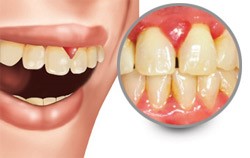
Figure: Pregnancy Granuloma
How is it caused?
The exact cause is not known. Hormones, an altered immune system, poor oral hygiene, and even viruses have all been suspected.
What are the warning signs?
A lump or swelling that appears near the gum line, more commonly in the upper jaw. The lump typically bleeds on toothbrushing. It is slow-growing and usually painless.
Changes in the teeth – tooth erosion
Tooth erosion is a condition in which the teeth are attacked by acids that soften the very hard enamel surface. The softened surface is then very susceptible to abrasive wear, and the tooth literally melts away. The softened tooth surface can be rehardened by the minerals in saliva and fluoride in mouthrinses and toothpastes. Tooth erosion is becoming much more widespread in the population and the risks increase during pregnancy.
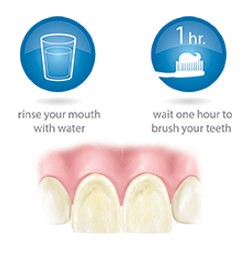
Figure: The features of tooth erosion are a lack of surface luster, yellowing, and the teeth gradually becoming smaller as the enamel is dissolved away.
How is it caused?
Erosion is caused by acids from two sources. Severe morning sickness with frequent vomiting enables stomach acids to regurgitate into the mouth. Foods and drinks, even “healthy” ones, contain many acids. Many fruits and fruit juices as well as carbonated drinks are rich in acids. Once in the mouth, the acids will attack and soften the enamel layer covering the teeth. The softened enamel can then be easily worn away leading to tooth wear, sometimes called acid-erosion.
What are the warning signs?
The early symptoms are mild twinges or sensitivity to hot or cold drinks, cold winter air, or toothbrushing with cold water in winter. As the erosion continues, the teeth change in their appearance. They lose their surface texture and may appear dull and not so shiny. The color of the teeth, especially the front ones, may also appear to become a deeper yellow. In extreme cases the shape of the tooth will change, becoming shorter with brittle edges.
HERE’S WHAT TO DO FOR GOOD ORAL HEALTH DURING YOUR PREGNANCY:
Get a Check-up.
Schedule a dental check-up as soon as possible and ask your dentist and dental hygienist for any specific advice they have to offer for your situation. Dental care is safe during pregnancy. Your dental team will work to schedule the optimal time for any treatment, contacting your obstetrician if needed.
Strive to have the best oral hygiene. Use the best toothbrushes.
For All teeth and gums:
Brush all teeth and gums thoroughly with a good quality toothbrush that is designed to reach into and help clean all the difficult-to-reach areas. It is here that the dental plaque builds-up – especially along the gum margin, under the gums, and between the teeth.

Figure: Toothbrushes with extremely tapered bristles can reach further under the gum and between the teeth in the hard-to-reach areas than regular “end-rounded” bristles.
Hold the brush so the bristles are pointing toward the gum margin at 45 degrees to the tooth roots and move the brush back and forth with short strokes, making sure all surfaces and sides of all teeth get brushed equally. This should take about two minutes to do well. Check with your dental hygienist for the technique that suits your mouth best.
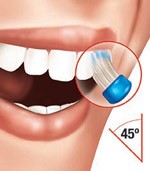
Between the teeth:
Toothbrushes are not able to clean perfectly in the hard-to-reach areas between the teeth – a place where bleeding often happens and gum disease starts. Each day use an interdental brush to clean between each and every tooth. With the correctly designed product this between-teeth cleaning is both very simple and very effective. Dental Floss may also be used in place of, or along with, an interdental brush but is more difficult to perform and is not any more effective.
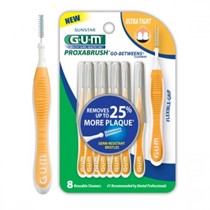

Toothpaste:
Use fluoride toothpaste twice per day, brushing with it for two minutes to gain maximum benefit of the fluoride binding to the enamel. If prone to tooth erosion, try to choose a gentle, low-abrasive paste and avoid whitening pastes that may be more abrasive to the softened tooth surface.
Diet:
Keep a well-balanced diet as much as possible. If you are eating or drinking a lot of acidic foods and drinks (fruits, fruit juices, sodas, etc.) tell your dentist so that together you can keep erosion to a minimum. Increased need to snack frequently can lead to dental decay if sugary and starchy foods are taken as snacks and not just as part of a proper meal. Changes in your diet will no doubt occur throughout your pregnancy – tell your dentist.
Don’t forget!
Maintain your regular check-up visits during and after the pregnancy
Change your toothbrush at least every 12 weeks and your interdental brush every two weeks
Look after yourself and especially your oral health after the baby has arrived
Take your children for their first dental visit before their first birthday


